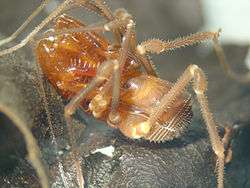Stygnommatidae
Stygnommatidae is a small neotropical family of the harvestman infraorder Grassatores with about thirty described species.[1]
| Stygnommatidae | |
|---|---|
 | |
| Stygnomma sp. from Costa Rica | |
| Scientific classification | |
| Kingdom: | |
| Phylum: | |
| Class: | |
| Order: | |
| Suborder: | |
| Infraorder: | |
| Superfamily: | |
| Family: | Stygnommatidae Roewer, 1923 |
| Species | |
|
See text for list. | |
| Diversity | |
| 2 genera, c. 30 species | |
Description
Stygnommatidae range from three to six millimeters in body length. Some species have chelicerae that effectively double their length. The pedipalps are strong, enlarged and armed. The legs are relatively short. These harvestmen dwell in litter, with some species found in caves.[1]
Distribution
Members of this family are found in the neotropics from Mexico to Brazil. Some species are found in southern Florida and others in Indonesia and Malaysia, but it is not sure that these belong into this family.[1]
Relationships
The monophyly of this family is disputed. Its closest relatives within the Samooidea are Samoidae, Biantidae and Podoctidae.[1]
Name
The name of the type genus is combined from the genus name Stygnus and Ancient Greek omma "eye", referring to the eyes that are separated like in Stygnus.[1]
Species
- Stygnomimus Roewer, 1927
- Stygnomimus conopygus (Roewer, 1927)
- Stygnomimus malayensis (Suzuki, 1970)
- Stygnomma Roewer, 1912
- Stygnomma annulipes (Goodnight & Goodnight, 1947) — Mexico
- Stygnomma belizense Goodnight & Goodnight, 1977 — Belize
- Stygnomma bispinatum Goodnight & Goodnight, 1953 — Mexico
- Stygnomma delicatulum Rambla, 1976 — Ecuador
- Stygnomma fiskei Rambla, 1969 — Jamaica
- Stygnomma fuhrmanni Roewer, 1912 — Colombia, Costa Rica, Panama, Venezuela
- Stygnomma furvum M. A. González-Sponga, 1987 — Venezuela
- Stygnomma gracilitibiae M. A. González-Sponga, 1987 — Venezuela
- Stygnomma granulosa (Goodnight & Goodnight, 1947) — Belize
- Stygnomma joannae Rambla, 1976 — Ecuador
- Stygnomma larense M. A. González-Sponga, 1987 — Venezuela
- Stygnomma leleupi Rambla, 1976 — Ecuador
- Stygnomma maya Goodnight & Goodnight, 1951 — Mexico
- Stygnomma monagasiensis H. E. M. Soares & S. Avram, 1981 — Venezuela
- Stygnomma ornatum M. A. González-Sponga, 1987 — Venezuela
- Stygnomma pecki Goodnight & Goodnight, 1977 — Belize
- Stygnomma planum Goodnight & Goodnight, 1953 — Mexico
- Stygnomma purpureum M. A. González-Sponga, 1987 — Venezuela
- Stygnomma solisitiens M. A. González-Sponga, 1987 — Venezuela
- Stygnomma spiniferum (Packard, 1888)
- Stygnomma spinipalpis Goodnight & Goodnight, 1953 — Mexico
- Stygnomma spinulatum (Goodnight & Goodnight, 1942) — Puerto Rico
- Stygnomma teapense Goodnight & Goodnight, 1951 — Mexico
- Stygnomma toledensis Goodnight & Goodnight, 1977 — Belize
- Stygnomma truxillensis M. A. González-Sponga, 1987 — Venezuela
- Stygnomma tuberculata Goodnight & Goodnight, 1973 — Mexico
Footnotes
- Pérez Gonzales, Abel (2007): Stygnommatidae. Roewer, 1923. In: Pinto-da-Rocha et al. 2007: 229ff
References
- Joel Hallan's Biology Catalog: Stygnommatidae
- Pinto-da-Rocha, R., Machado, G. & Giribet, G. (eds.) (2007): Harvestmen - The Biology of Opiliones. Harvard University Press ISBN 0-674-02343-9